Since the birth of the cinema over a century ago, more than 300 films and television
shows from around the world have adapted the stories of Jules Verne (1828-1905)
to the screen, and another hundred have told of his life and work. Other the 80-day
races around the world of Phileas Fogg and his descendants, and the undersea exploits
of Captain Nemo derived from Twenty Thousand Leagues Under the Seas and
The Mysterious Island, no Verne title continues to appear as often on the
screen as Journey to the Center of the Earth. It has been told in movie
and television form more than a dozen times--and on many other occasions for radio
and stage, including musical and opera, and most recently in video games. The screen
versions include a 1910 French short film; theatrical features from Hollywood in
1959, 1988, and Spain in 1977; Canadian, Australian, Spanish, and American animated
specials; a Hollywood animated series; and an American television pilot, live action
mini-series, and its remake. Such an examination of the full extent of adaptations
and their possibilities, with their implications for how narrative incidents are
treated in these different forms, has not been undertaken before.[1] A chronological survey reveals how
an intertextual process has developed among these screen versions, increasingly
partaking as much from one another as the Verne source.
Voyage au centre de la terre was first published in Paris in 1864, and
vivified geology, fictional scientific exploration, and prehistoric life in a manner
that was new to literature. Avoiding intrigue, villains, or satire, Verne provides
a direct account of the descent into a strange world, a contemporary expedition
following the route of an imaginary 16th century alchemist, Arne Saknussemm. He
left behind instructions on how to locate the path in coded runic lettering on an
old parchment, although the obvious question of just how Saknussemm may have discovered
the route is never broached. The trip begins and ends on a perfect parallel: commencing
with a peaceful descent into the extinct Icelandic volcano of Snæfels, and
violently returning to the surface from the earth’s interior in an eruption
from a live volcano, Stromboli.
The three travelers are young Axel, his uncle, professor Otto Lidenbrock, and Hans
Bjelke, an Icelandic guide and hunter, embodying contrasting mythic types: the young
hero, the scientist, and the quiet assistant. Lidenbrock fails to heed the obvious
question of how the trip will end, while Axel expresses natural trepidation and
uncertainty. For him, the experience of the expedition becomes transformative, as
he frankly admits and then overcomes his own fears, striving to live up to the expectations
of both his uncle and his sweetheart, Graüben. Hans stoically facilitates the
journey of Lidenbrock and Axel, without emotion or question, providing the tools
and muscular support the others need.
The geographical expedition is varied by making it a trip back in biological and
geological time--the deeper the explorers go, the farther they travel into the past.
Journey to the Center of the Earth remains squarely within modern definitions
of the science fiction genre, retaining all of the compelling originality and imagination,
and does not have the aura of science fiction set in the past that now sometimes
seems to date Verne’s novels, such as Twenty Thousand Leagues Under the Seas
or From the Earth to the Moon and Around the Moon. The “prophecy”
of submarines and moon travel has been fulfilled--unlike Journey to the Center of
the Earth.
Science fiction stories appropriately first appeared in the early genre of trick
films, based on the processes inherent in the new medium, such as stop motion, fast
or slow motion, dissolves, and multiple exposures. The first film of the novel was
created by Segundo de Chomon, a pioneer director, animator, and cameraman who worked
throughout Europe. His VOYAGE AU CENTRE DE LA TERRE was produced in France in December
1909 and had a length of 528 feet, lasting some 9 minutes. Released worldwide in
1910 by Pathé Freres, in England it was titled A JOURNEY TO THE MIDDLE OF
THE EARTH, while in the United States it was issued as INSIDE THE EARTH. Liberally
adapted, four travelers--two Englishmen and their guides--are shown emerging from
the sets of grottos and caverns in a theatrical manner, miming the action. As they
discover the Earth’s interior, transformations surround them; for instance,
gigantic mushrooms spring up spontaneously. An appalling array of fierce creatures
appears suddenly, including elephants, crocodiles and huge frogs, terrifying the
explorers. Passing through streams of fire and molten lava, they return to the surface,
pleased at their safe deliverance.[2]
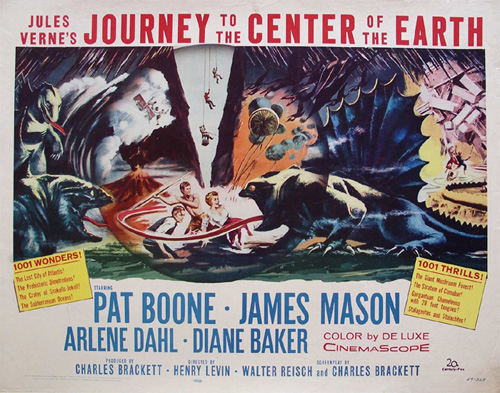
Fifty more years would pass before filmmakers again adapted Verne’s novel.
Hollywood writer-producer Charles Brackett had long cherished the dream of filming
it, but had been told that an expensive fantasy with a period setting could not
be profitable. The enormous box-office success of Walt Disney’s 20,000 LEAGUES
UNDER THE SEA (1954) and Michael Todd’s AROUND THE WORLD IN 80 DAYS (1956)
proved the contrary, and JOURNEY TO THE CENTER OF THE EARTH became a $4.5 million
1959 Christmas release of the highest technical quality by 20th Century-Fox.[3]
Brackett coauthored the screenplay with Walter Reisch, who had studied Verne with
the intention of writing a biography. Reisch believed only the novel’s premise
was successful.[4] Even
before the narrative begins, the title sequence perfectly captures, in a visual
metaphor, the trip the characters and the audience are about to undertake. The camera
moves steadily closer to an Earth revolving in space, until finally it becomes so
close it fades to black, and finally out of the darkness emerge shots of spewing
lava and a red volcano.
The initial setting is moved from Germany to Edinburgh in 1880 to accommodate the
stars and to eliminate the need for German heroes only 14 years after the end of
World War II. Otto Lidenbrock becomes Oliver Lindenbrook, played by James Mason,
who was 50 at the time, the age Verne had given his hero. While Mason had provided
the authoritative movie portrayal of Captain Nemo in 20,000 LEAGUES UNDER THE SEA
five years earlier, his Lindenbrook is far less true to the source.[5] Instead of Verne’s eccentric,
the movie substitutes a note of temper, accenting misogyny and a lack of social
graces. Indeed, the professor’s elitist pretensions will be mocked when he
misinterprets the noise of a duck foraging for food with a code in a foreign language.
Some of the changes derive from the fact that the part had been intended for Clifton
Webb, who withdrew due to illness only weeks before shooting began.
Lidenbrock’s nephew Axel became favorite student Alec (Pat Boone), in love
with the professor’s niece Jenny (Diane Baker), equivalent to Graüben
in the novel; she receives star billing despite a small role. Although cast to appeal
to teen filmgoers, Boone perfectly incarnates Alec. Boone saw the science-fiction
assignment as a down-turn in his career, and earnest persuasion and a percentage
of the profits were necessary to convince him to take the role.[6] While several songs were inserted for him, with
music by James Van Heusen and lyrics by Sammy Cahn, they were minimized and concentrated
early in the picture, preventing his musical persona from interfering with the narrative.
Alec’s maturing on the trip is evident in the film, as for the first time
he is required to demonstrate courage and heroism.
In place of the parchment cipher from Saknussemm, his message is written in blood
on a plum bob encased in a piece of lava. The local ambience and 19th century atmosphere
are effectively captured through Edinburgh location photography, but the Icelandic
scenes are unconvincing, resembling a backlot more suitable for a western.
Brackett and Reisch added human antagonists to Verne’s inherent natural obstacles.
Lindenbrook confides Saknussemm’s note to a Swedish professor, Goetaborg,
only to find that Goetaborg has decided to undertake the trip himself. When Goetaborg
is found mysteriously dead, this allows a variation on the romantic theme. Although
the obvious step would be to simply have Alec’s beloved Jenny join the expedition,
a more active heroine was incorporated. Goetaborg’s widow, Carla (Arlene Dahl),
is every bit as prickly and headstrong as Lindenbrook himself. She will provide
Lindenbrook with her late husband’s essential supplies only if she accompanies
the expedition. The eventual romance with a middle age couple stands in for the
largely unseen Alec-Jenny ingénue romance, Jenny appearing briefly in lonely
intervals on the surface wondering what is happening below. At the same time, largely
because he is matched by Carla, the journey becomes a humanizing experience for
Lindenbrook no less than a maturing one for Alec.
Carla proves of practical use as the only one who shares a language in common with
Hans. Actor Peter Ronson (nee Rognvoldsson) was the decathlon champion of Iceland,
and also technical advisor of the film, but understood and spoke little English,
just like the character he played. Hans was given stronger motives and turned into
a source of mild amusement; perhaps best remembered by children is his pet duck,
Gertrude, who joined the expedition--although Verne had described Hans as a duck-hunter!
Goetaborg had shared his information with the modern descendant of Arne Saknussemm,
a scientist in his own right. Thayer David replaced Alexander Scourby in the part
after the first few days of production, in a one-dimensional role. The imperious
Count Saknussemm believes the underworld is his by inheritance and had poisoned
Goetaborg.
Together the complex plot and deliberate pace combine to create a genre movie that
does not seem too far-fetched.[7]
By slowly easing the viewer into the situation--50 minutes pass before the descent
begins--the journey is given an aura of possibility and even fact. Through the addition
of new characters--the rivalry first with Goetaborg, then with Saknussemm, and the
menace provided by both--the screenplay reveals its construction around overlapping,
interconnected events. Similarly, the visuals provide the same pattern with the
rival Saknussemm and Lindenbrook expeditions, epitomized by the search for Alec
while the explorers traverse the same terrain he has already passed.
Unlike the book, the initial descent is in a more horizontal than vertical direction.
The use of actual caves provides an eerie sense of authenticity to the underground
scenes, and only occasionally do they clash with over-designed movie sets. Filming
took place in Carlsbad Caverns, New Mexico, descending to depths of 1100 feet, beyond
the areas seen by tourists, although the crew and principal cast shot at night so
as not to interfere with them.
Visually, JOURNEY TO THE CENTER OF THE EARTH is a continuous feast for the senses
and won four Academy Award nominations, for Sound, Art Direction, Set Decorations,
and Special Effects.[8]
The story is ideal for widescreen treatment, and director Henry Levin imaginatively
composes the staging and images to take advantage of the Cinemascope ratio of 2:35
to 1. Camera angles subtly reveal the position of characters, and nearby menaces,
from Saknussemm to a monster’s observant eye. This, together with the long
running time of 132 minutes, helps to capture a sense of the epic immensity of their
journey (given as 256 days before the discovery of the mushroom forest).
Equally important are the sound effects and the score. Bernard Herrmann’s
music varies between the deepest sounds to loud, high-pitched music. He explained
in 1974 album notes, “I decided to evoke the mood and feeling of inner Earth
by using only instruments played in low registers. Eliminating all strings, I utilized
an orchestra of woodwinds and brass, with a large percussion section and many harps.
But the truly unique feature of this score is the inclusion of five organs, one
large Cathedral and four electronic. These organs were used in many adroit ways
to suggest ascent and descent, as well as the mystery of Atlantis.”
When Saknussemm is captured by the Lindenbrook group, he remains aloof, as if he
had some secret knowledge. For instance, he is the first to realize that they no
longer need their lamps to see underground because a luminescent algae now grows
on the cave walls, which is how his ancestor survived without modern lamps.
The encounters with dinosaurs at sea are transferred to the scenes ashore, on the
beach, preceding the launch of the raft. Rows of sail-like spines were attached
to the backs of two-foot Haitian iguanas prior to photography, enlarged as necessary
through double exposures and other effects, with their movements altered by increasing
camera speed.[9] The raft
journey across the underground ocean is minimized. Suddenly all metal is plucked
away from them, and Lindenbrook announces that they must have reached the conjunction
of the magnetic poles as the raft is drawn into a whirlpool. Unlike the novel, the
destination promised by the title is thus reached.
Their raft wrecked, the members of the expedition drag themselves ashore, now virtual
castaways. When Hans awakes and follows Gertrude’s tracks, he discovers that
Saknussemm ate his duck, and advances menacingly toward him until Saknussemm trips
and tumbles to his death.
His fall points the way towards a cavern containing the ruins of the lost city of
Atlantis. This incident was borrowed from Twenty Thousand Leagues Under the Seas,
but had not been used in the Disney movie.[10]
Among the crumbled stones and pillars, the right hand of Arne Saknussemm’s
skeleton points to a shaft. By using some gunpowder still remaining in Arne Saknussemm’s
kit, they set a fuse to dislodge a stone that blocks the way.
Buried within the ruins of Atlantis is a giant reptile, which turns red as it is
awakened by the explorers. Lindenbrook is seized by the serpent’s tongue,
but saved by Alec’s quick intervention--echoing the scene five years earlier
of Mason, this time as Nemo, seized by a tentacle of the giant squid in 20,000 LEAGUES
UNDER THE SEA and saved by Ned Land.
The explorers had fortunately taken refuge in a cup-shaped altar stone, which now
acts as a vessel, protecting them from the ensuing volcanic eruption, providing
a safer, more believable conveyance than Verne’s wooden raft in the novel.
The altar stone is carried to the surface in one of the most superbly visualized
scenes, shown schematically pushed up through the chimney on top of rocks propelled
by lava. The explorers brace themselves against the stone, the camera looking down
directly at them as they are transfixed by the pressure of the wind. They, in turn,
see the walls of the cavern race by, and, looking up, see a gradually growing spot
of light that represents the surface. Through these three key shots, the difficult
concept of the return to the surface is ideally expressed in cinematic terms that
make clear to the audience what is occurring. The achievement is all the more impressive
considering that none of the other screen versions convincingly portray this crucial
scene from the novel.
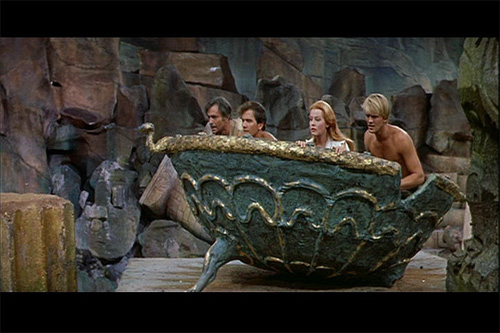
While not an overpowering film, in the manner of 20,000 LEAGUES UNDER THE SEA, JOURNEY
TO THE CENTER OF THE EARTH does not show its age in the manner caused by the former’s
topical references to the atomic age, or the pretentiousness the same allusions
give to FROM THE EARTH TO THE MOON (1958). Similarly, though leavened with humor,
the amusing ingredients of JOURNEY TO THE CENTER OF THE EARTH are incidental to
the plot and situations, becoming an integral element of the long trek in a film
that is never needlessly serious. It is a much quieter film that stands up surprisingly
well to repeated viewing and different generations of viewers. Despite being shorn
of its Cinemascope dimensions on the small screen, where it became popular in the
late 1960s, the movie was simultaneously re-released overseas well into the 1970s.
Today the film is still widely seen in video release.
One amusing follow-up event occurred in 1978. When James Mason provided a one-hour,
condensed reading of the novel for Caedmon audio, directed and abridged by Ward
Botsford, ironically the bogus 1871 translation was used. Sadly still in print today,
this English rendering had added incidents to the story and changed the principal’s
names, most notably Lidenbrock to Von Hardwigg and Axel to Harry. Mason must have
been left to wonder about the derivation of the Lindenbrook character he had played.
While Verne’s Journey to the Center of the Earth was republished
in England and the United States on some fifteen occasions in the fifty years between
the official adaptations by Segundo de Chomon and 20th Century-Fox, it has been
republished over fifty times in the years since the 1959 film.[11] The steadily growing popularity of Journey to the Center
of the Earth on the screen has made it the third most widely read Verne
novel after Around the World in Eighty Days and Twenty Thousand Leagues
Under the Seas. This suggests that accelerating interest in the novel,
continuing enjoyment of the 1959 movie, and the frequency of other film, television,
radio, and stage adaptations since then have become mutually reinforcing, each fueling
the demand for the other.
Verne’s classic tale has found a home not only on the large screen, but came
to television as a Saturday morning cartoon during the 1967-69 seasons, when ABC
aired a sequence of 17 animated films under the series title JOURNEY TO THE CENTER
OF THE EARTH. Directed by Hal Sutherland, these were produced by Louis Scheimer
and Norman Prescott for Filmation (helping to launch the studio) in association
with 20th Century-Fox Television, with the plot based on the studio’s
1959 movie.[12] The narration
of the prefatory sequence set the premise and mood.
Long ago, a lone explorer named Arne Saknussemm made a fantastic descent to the fabled lost kingdom of Atlantis at the Earth’s core. After many centuries, his trail was discovered, first by me, Professor Oliver Lindenbrook, my niece Cindy, student Alec McKuen, our guide Lars and his duck Gertrude. But we were not alone. The evil Count Saknussemm, last descendant of the once noble Saknussemm family, had followed us, to claim the center of the Earth for his power-mad schemes. He ordered his brute-like servant Torg to destroy our party. But the plan backfired, sealing the entrance forever. And so for us began a desperate race to the Earth’s core, to learn the secret of the way back. This is the story of our new journey to the center of the Earth.
Together with visuals repeated over the closing credits, the series is situated
as simultaneously an alternate version of the 1959 movie, and a possible sequel.
Hans becomes Lars (given a humorous Swedish accent), and Cindy takes the place of
both Jenny and Carla, but is the love interest of no one. Gertrude, too well remembered
by young viewers of the movie, had to be revived from her ignominious end as Count
Saknussemm’s last meal.
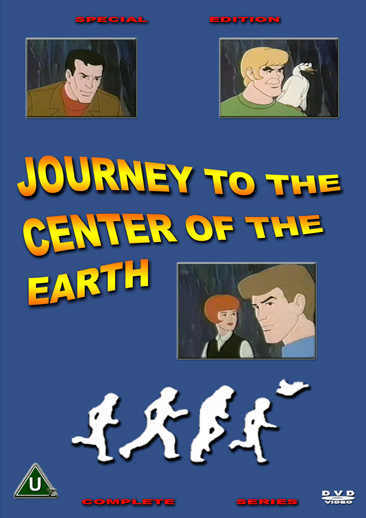
Unlike the careful plotting of the movie, the series is geared strictly toward children,
with cheap animation.[13]
The catch phrase was “No stopping--we’ve got to keep moving,”
with a silhouette of the four main characters running, Gertrude flying just ahead.
Each episode consists of repetitious incidents relating the momentary menace of
a monster or some other peril, like a man-headed spider. The escapes are no more
probable than the danger, such as fleeing a volcanic eruption by riding a wave of
lava surfboard-style.[14]
Nonetheless, more is derived from the novel than might be expected in a series of
this type; in the episode REVENGE OF THE FOSSILS, a race of prehistoric men are
discovered by Lindenbrook and accidentally revived and become menacing, while in
CREATURES OF THE SWAMP the Lindenbrook group journey via raft. In ARENA OF FEAR,
they navigate via raft, and encounter a giant prehistoric man.
By contrast, a single 48 minute animated television version in 1976 fully realized
the potential of both the medium of television and animation in an original that
is a competitor for the best adaptation in any form. A JOURNEY TO THE CENTER OF
THE EARTH (distinguishable from other versions as the one only one to retain the
article “A” from the initial English-language translation in 1871) was
directed by Richard Slapczynski and scripted by Leonard Lee, and was the best of
more than a half-dozen Verne adaptations produced in the 1970s by Walter J. Hucker
and Air Programs International for Burbank Films in Australia.
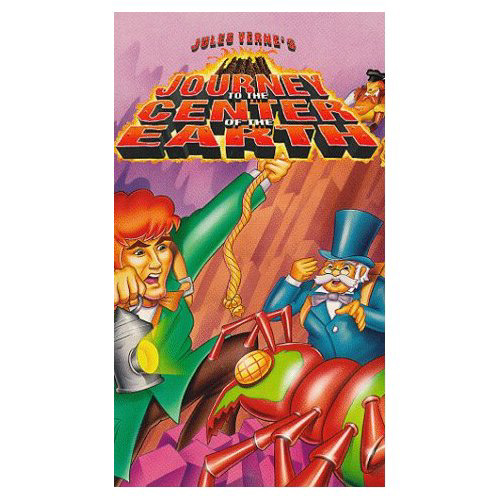
While diverging considerably from the novel in numerous details, A JOURNEY TO THE
CENTER OF THE EARTH treats the story and characters with commendable respect and
verve. The likelihood of the story is enhanced by a huge spherical miniature replica
of the Earth. With it, Professor Lidenbrock apparently proves that if the interior
were as hot as supposed, the whole planet would explode--just as his model had done.
The Hamburg Scientific Society ridicules his conclusion that the interior of the
Earth must be much cooler than generally thought, and may even contain life.
Lidenbrock is the town’s accepted eccentric, and this combines with his genius
to form a whole character. His housekeeper and neighbor’s bemused, accepting
reactions to his experiments add a humorous sidelight; as in the novel, Lidenbrock’s
housekeeper, Martha, becomes a full-fledged participant. With this carefully establishment
of the personalities and treatise (like the 1959 movie), the program is slow to
start, using half its running time before the descent gets underway.
Lidenbrock is inspired by an old runic book by Arne Saknussemm, in which invisible
writing is brought out by heat that also burns up the clue before it has been fully
read. Arriving in Iceland, Lidenbrock and Axel discover the locals fear the slumbering
volcano Scartaris, for legend has it that centuries ago an expedition of fifty men
went down it, with only one returning over a year later, who refused to tell what
happened (all shown impressionistically). Only Hans volunteers to go with them;
for once, he is a believable and courageous character, and not a source of humor.
Following the news of the trio are two disbelieving scientists from Hamburg, Kippner
and Benz. They are jealous of the fame Lidenbrock’s exploits might garner,
and although a rather hackneyed plot device, the scenes with Kippner and Benz provide
a more likely interjection of an antagonist than the 1959 movie’s introduction
of rival expeditions.
The expedition soon runs out of water, and Axel faints and becomes lost. Here, and
at several other points in the story, the visuals adopt Axel’s subjective
point of view, approximating the first-person narration of the novel. The novel’s
separate episodes of Axel’s rescue and the finding of water are effectively
conflated here, and they also find the skeletons of the many other men who had traveled
with Saknussemm--an eerie sequence that provides one of the few attempts to seriously
suggest the outcome of the first expedition to the center of the Earth.
Arriving at the underground sea, Saknussemm’s raft is found waiting, perfectly
preserved after 200 years. Their compass useless, they sail aimlessly, and go even
farther than Saknussemm, entering into a swamp where their raft is wrecked. They
walk through a giant mushroom forest, past a sabre-tooth tiger, and enter a cave.
Better than any other version, A JOURNEY TO THE CENTER OF THE EARTH thoroughly mixes
different types of prehistoric life, in the way Verne intended.
When the travelers are also menaced by giant insects with luminous eyes (who had
earlier appeared in a hallucination to the thirsty Axel), Lidenbrock fights back
with dynamite. This in turn causes a flood of high pressure boiling water that returns
them to the surface of the Earth, on Stromboli. Returning to Hamburg, Lidenbrock
and Axel find Kippner and Benz placing a memorial plaque to the presumably deceased
explorers. Doubts are met with proof as Axel pulls a huge egg from his knapsack,
which promptly hatches as a baby pterodactyl. This unacknowledged borrowing from
Sir Arthur Conan Doyle’s The Lost World is an appropriate homage
considering the latter’s inspiration from Verne.
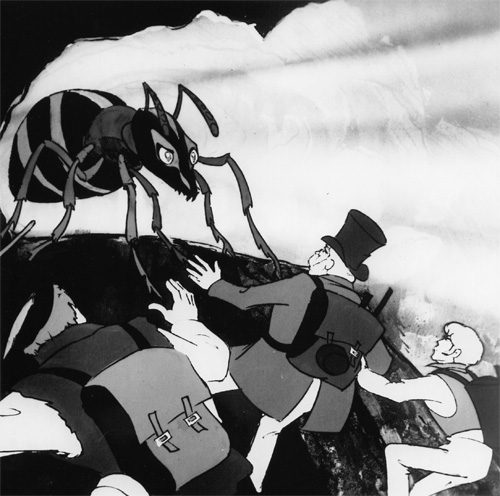
The visual treatment is both lively and realistic, with considerable pictorial detail,
and imaginative and effective color schemes. For instance, kaleidoscopic light effects
introduce the underground sea, and the caverns are initially patterned emphasizing
shades of red, while blues are added as they reach the antediluvian world. Despite
the ostensible limitations of its medium as an animated television program, A JOURNEY
TO THE CENTER OF THE EARTH retains more of the original novel and adds fewer melodramatic
elements than any of the live-action feature versions. Changes (such as switching
from lava to boiling water carrying them to the surface), or additions (like the
giant Earth model), are compatible with Verne. Many of the episodes are handled
far more effectively than in the live action versions, such as the sequence of Axel
lost and alone, in comparison with the 1959 version.
The next year Verne’s novel was remade as a Spanish live-action coproduction.
VIAJE AL CENTRO DE LA TIERRA received limited distribution in 1978 in the United
States by International Picture Show under the title WHERE TIME BEGAN; it was initially
titled JULES VERNE’S FABULOUS JOURNEY TO THE CENTER OF THE EARTH. Made for
$2 million (less than half the budget of the 1959 film, without considering inflation),
WHERE TIME BEGAN was shot over a period of five months. With a running time of only
90 minutes, WHERE TIME BEGAN, scripted by John Melson, Carlos Puerto, and Juan Piquer
Simon, uses most of Verne’s major incidents. Producer-director Piquer Simon
had read all of Verne’s novels as a boy, and eagerly turned to the author
for inspiration as he helmed his first film. He subsequently wrote, produced, and
directed two other Spanish adaptations of Verne, turning The School for Robinsons
(1882) into the disappointing MONSTER ISLAND / MYSTERY OF MONSTER ISLAND (1981),
and A Fifteen-Year-Old Captain (1878) into the satisfactory African adventure
LOS DIABLOS DEL MAR / SEA DEVILS (1982).
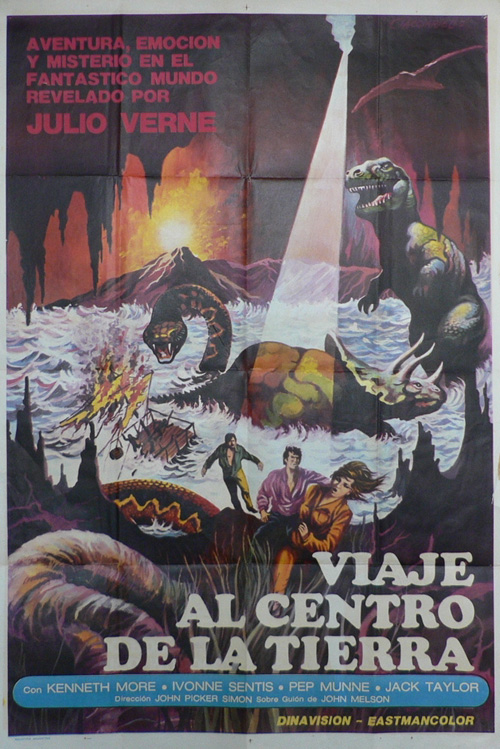
WHERE TIME BEGAN opens with a pre-credit discussion of the interior of the Earth
by a group of geologists, with Professor Otto Lidenbrock (Kenneth More) commenting
that the only way to prove any of the theories is through an actual descent. The
credits follow, superimposed over a pleasant salute to the Vernian visual style
of Georges Méliès, using excerpts from his VOYAGE À TRAVERS L’IMPOSSIBLE
/ AN IMPOSSIBLE VOYAGE / WHIRLING THE WORLDS (1904) and the seldom seen 200,000
LIEUES SOUS LES MERS / 200,000 LEAGUES UNDER THE SEA / UNDER THE SEA (1907)--but
marred by an inane song on the soundtrack. Piquer Simon intended a tribute to his
fellow countryman, Segundo de Chomon, who had first filmed Journey to the Center
of the Earth almost 70 years earlier.
Piquer Simon moves up the date of the story to 1898, to make it more contemporary
for the audience, in both technology and social mores (such as the place of women).
In Hamburg, an aged man tries to sell several old volumes at a book store; they
are bought by Lidenbrock. Arriving home, he finds the soldier Axel (Pep Munne) accidentally
kneeling before his niece Glauben (instead of Graüben, and played by Yvonne
Sentis), and assuming there has been a marriage proposal, gladly but offhandedly
offers his consent. Glauben notices the small note that falls from the book, and
together Lidenbrock, Axel, and Glauben, with the help of the cinematically referential
device of a magic lantern, discover the key to Saknussemm’s code.
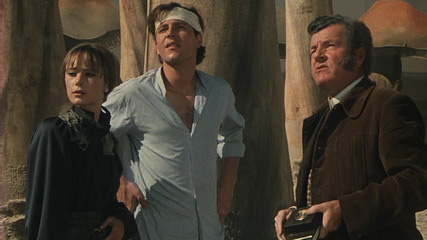
Under the same necessity to add a feminine lead as other versions, WHERE TIME BEGAN
follows a vastly simpler method. Glauben wants to go on the trip, and her practicality
proves a valuable assistance to the absent-minded Lidenbrock and equally ill-prepared
Axel. By contrast, it is Axel who is uncertain, hesitant, and reluctant; the juxtaposition
of his equivocation with Lidenbrock’s certainty and Glauben’s eagerness
provides humor that was not in the novel. Axel is still the narrator of the journey,
his exposition helping to expedite the plot, even as his failure to recognize his
own frailties is amusing. By contrast, Hans (Frank Brana) is closer to the man of
brawn Verne described; the only concession to humor is in showing how he imagines
the pay for his efforts--in sheep for his flock.
The exteriors of the expedition’s beginning and exit through craters were
taken at the Lanzarote volcano in the Canary Islands, providing a barren, other-worldly
appearance that almost resembles a moonscape. Although the reddish plains scarcely
resembled Iceland, a series of extreme dramatic zooms impressively isolates the
cast amidst the desolate location, providing a more dynamic lead-up to the descent
than in the 1959 movie.
The plunge into the Earth was shot a half-mile inside caves near Madrid, with the
lighting effectively dark and claustrophobic. Piquer Simon recalled, in a letter
to the author, that the humidity was 99 degrees, and that they remained “trapped”
for ten days in this environment, working over 9 hours each day. The caverns are
convincingly varied and realistic, without the interspersing of obvious and jarring
studio sets that marred the 1959 version.
In a cave of winds, Lidenbrock loses Saknussemm’s book that helped guide them
through the first forks in their path. When Hans’s pickaxe thrust releases
boiling water, it burns the hand of the man Glauben had seen in the darkness--who
finally introduces himself as Olsen (Jack Taylor). Olsen says he entered (and will
leave) the interior of the Earth through another opening and has been traveling
alone for two months. As in the 1959 version and its imitators, the filmmakers of
WHERE TIME BEGAN apparently believed that it was necessary to add a second expedition
that met up with the Lidenbrock group. However, although Olsen is even less related
to the novel than the descendant of Saknussemm, his actions are not as disruptive
as the modern Count Saknussemm’s villainous hue.
The underground sea seems to have a healing physical power over the members of the
expedition. As Hans builds the raft, Lidenbrock, Axel, and Glauben explore the shoreline,
including the forest of giant mushrooms. Claiming he has scientific experiments
of his own to perform, Olsen sets off a series of explosions in the sea. Glauben
notices that Olsen never seems to require sustenance, and his only tool is a copper-colored
metal box he carries with him (which unfortunately resembles in size and shape nothing
so much as a metal tea-kettle).
The sequence around the underground sea is, as in the novel, the centerpiece of
the story, and the full treatment of this setting and the incidents around it--the
island, the dinosaurs, the storm--with a large degree of fidelity to Verne, make
WHERE TIME BEGAN noticeably different from other films of the novel. More impressive
than the blue of the sea in the 1959 version, in WHERE TIME BEGAN filters turn the
ocean a deep shade of greenish-blue aqua, contrasting with the orange of the land;
the striking color combinations make the setting all the more convincing.[15]
Washed ashore with the wreckage of their raft and their equipment after the storm,
Axel and Glauben go in search of Olsen, passing through a field of fossils and into
a forest. At this point, WHERE TIME BEGAN becomes increasingly far-fetched, failing
to live up to what has gone before. Axel and Glauben are suddenly attacked, not
by the ten foot prehistoric man of Verne’s imagination, but by a giant ape
who appeared as a matter of production expedience, but failed to connect with Verne’s
evolutionary link. Olsen comes to the rescue, escorting Axel and Glauben through
a cave where they see, in the distance, a whole city of men who resemble Olsen,
each carrying an identical metal box and dressing in a similar Russian tunic and
hat. Passing more dinosaurs on their return to the shore, they eagerly rejoin Lidenbrock
and Hans aboard the reconstructed raft.
Olsen sets off an explosion that will open an escape for Lidenbrock, Axel, Glauben,
and Hans, saying he will find his own way to safety. The scene comes rather suddenly,
and is confusing in its brevity and lack of explanatory dialogue. (WHERE TIME BEGAN
avoids saying whether the expedition actually reached their destination or not,
so there is no sense of the downward distance they have traveled.)
In a coda, Axel and Glauben have married, Hans is once more a prosperous sheepherder,
and Lidenbrock still haunts the old bookshop. One day, he learns that a parcel has
been left for him, and, unwrapped, it proves to be Olsen’s metal box. Looking
toward the shop window, Lidenbrock sees an aged man, the same one who brought in
Saknussemm’s journal--and recognizes that he is “Olsen.” This
parallel closure brings the film back to where it began, and in supplying another
clue, hints at greater mysteries still to be discovered.
In the original Spanish version, Olsen is named Amutsen, hinting at the name of
the polar explorer, but was intended by Piquer Simon to be a Martian who would serve
as another science fiction appeal to young audiences. However, as adapted into WHERE
TIME BEGAN, the character is far less defined and more open to interpretation. Is
Olsen perhaps meant to be Arne Saknussemm himself, or a representative of his pioneering
spirit? Either or both could be true; Olsen stands in for the absent predecessor
whose earlier journey they are recreating. Olsen is a common name but it also has
alliterative qualities with the name Saknussemm. Significantly, Olsen appears after
Lidenbrock loses Saknussemm’s original book, and will rescue the travelers
at the point where Saknussemm’s last carving of his initials appears. He is
less of a full-fledged character than a symbol, a vivid reminder of the theme of
time that, in the form of evolution, was such a motif of the novel.
The cast credibly enact their roles, and Kenneth More better captures the eccentricity
and mannerisms of Lidenbrock than had James Mason. However, at age 63, More too
often reveals his age, and seems to find the role--never mind the expedition--too
demanding physically; More was suffering the first symptoms of Parkinson’s
disease.
The cut rate special effects (by Emilio Ruiz) are variable; the dinosaurs are far
less convincing than those of the 1959 version, but WHERE TIME BEGAN also attempted
to do far more with them than the previous film, which had not even attempted to
stage the battle at sea. The picture’s most consistent virtue is the impressive
photography by Andres Berenguer, especially the volcanic surfaces, the caves, and
the underground ocean. Judged by its own standards and scale, WHERE TIME BEGAN must
be rated a very satisfactory although uneven effort.
The next three live action versions made their debt to the 1959 movie clear with
their adoption of its premise of the city of Atlantis located in the center of the
Earth, but none credited Verne. In 1986, Cannon Films made a new live action JOURNEY
TO THE CENTER OF THE EARTH, directed by first time helmer Rusty Lemorande and written
by Debra Ricci, Regina Davis, Kitty Chalmers, and Lemorande. Some of the main shooting
as well as postproduction and special effects were never completed, with the result
that it was shelved for several years. However, in 1989, after Cannon had gone defunct,
Viacom released an apparently finished 83 minute film as an original for home video
and eventual television distribution.
Only a few incidents from Verne remain as several juveniles become lost underground.[16] JOURNEY TO THE
CENTER OF THE EARTH becomes utterly incoherent as the focus shifts to an Atlantis
in the center of the Earth, meant as a funky in-joke that is utterly bizarre and
unfunny. The city is presented as a big-brother metropolis most reminiscent of George
Orwell’s novel, 1984.
The cause of this disconnected quality is the fact that JOURNEY TO THE CENTER OF
THE EARTH is actually the patchwork of two films. Director Albert Pyun offered to
complete the movie for free if he was also allowed to make another sci-fi film for
less than $1 million. This became ALIEN FROM L.A. (1988), in which Kathy Ireland
plays the daughter of a modern Professor Saknussemm. When he disappears, she reads
in his diary that humankind’s ancestors were alien colonists known as Atlanteans,
whose giant spaceship sank into the Earth.[17]
A new second half to JOURNEY TO THE CENTER OF THE EARTH was shot, rehashing ideas,
effects, sets and the cast from ALIEN FROM L.A., which was also coscripted by Debra
Ricci and Regina Davis.
On February 28, 1993, NBC premiered a new two-hour television movie pilot entitled
JOURNEY TO THE CENTER OF THE EARTH, which had even less relation to the novel than
the Cannon duo. A nuclear-powered craft descends into the shaft of an active volcano,
but becomes trapped as it explores the world underground on a quest for the knowledge
of Atlantis.
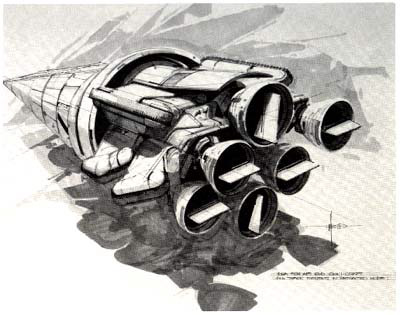
After live action movies had strayed steadily further from the source, animation
began to slowly find a path back to Verne. The outline of incidents appeared in
Saban’s 25 minute 1991 direct to video AN EXCELLENT JOURNEY TO THE CENTER
OF THE EARTH, written by Mark Ryan-Martin and produced by Eric S. Rollman and created
by Fuji Eight Co. While character names are changed and Saknussemm deleted, such
standard incidents are found as the youngest becoming lost, a mushroom forest, the
underground sea, a raft, and sea monsters. They reach an area where there is no
gravity, water floats in the air, and their compass goes wild; it is the core of
the planet (and the only visually imaginative scene). However, struck by lightning
in this region, the raft is wrecked and they wash ashore on a coast littered with
huge skeletons of fish. Turning their tent into a hot-air balloon provides rescue
from the lava taking them to the surface.
As the series title, “Funky Fables,” indicates, AN EXCELLENT JOURNEY
TO THE CENTER OF THE EARTH is filled with silly touches and pitiful attempts at
tongue-in-cheek satire that fail throughout. A narrator provides a postmodern commentary,
ruminating on the characters and events, and nearly every line is intended as a
joke of some sort, relying on slang and pathetic puns. The day the shadow of Scartaris
will point out the passage they are to descend is linked to Elvis Presley’s
birthday. In all, the low level of humor, combined with primitive minimalist animation
based on simple circular outlines drawn in a caricature style, leads inevitably
to a tiresome viewing experience.
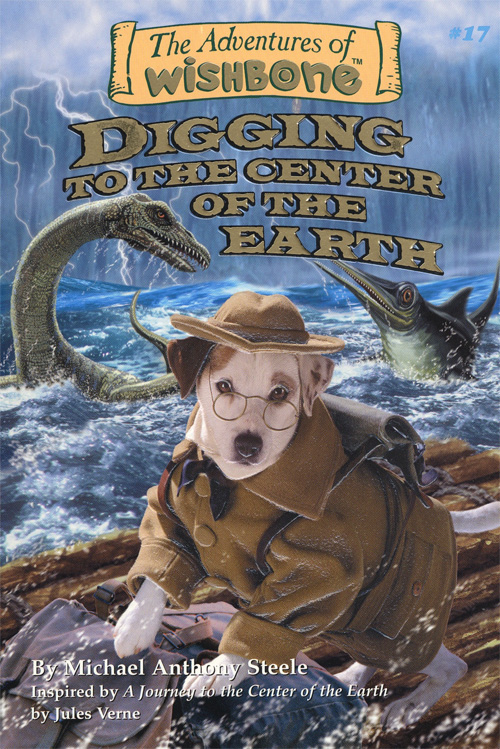
A more productive approach was found for HOT DIGGETY DAWG (1995), a segment of the
highly popular half-hour PBS children’s series WISHBONE, a Big Feats! Entertainment
production. Wishbone is a Jack Russell terrier, enlivening his mundane life by imagining
himself cast in famous stories--essentially a beginner’s version of the old
“Classics Illustrated” comic books.[18]
Each WISHBONE episode presents two parallel tales, alternating back and forth. In
the prosaic framing story, Wishbone is an ordinary family pet, providing an anthropomorphized
canine perspective, while in the inset story he becomes an appropriately costumed
canine, enacting a lead in a classic tale. Retaining the body of a dog in Wishbone’s
daydreams as he interacts with people as if he were one of them echoes the desire
of small children to be treated as “grown-ups” and be able to live the
seemingly freer possibilities of adult experience.
In HOT DIGGETY DAWG, written by Jack Wesley and directed by Fred Holmes, digging
a hole for an Arbor Day tree allows Wishbone to imagine himself as Professor Lidenbrock
in a series of Verne’s incidents with Axel (Jonathan Brent) and Hans (Matthew
Thompkins), including giving his last mouthful of water to Axel.
Back on the surface, the children are fascinated with a gold medallion that Wishbone
has dug up. Returning to the story of Journey to the Center of the Earth,
the discovery leads to an underground river inside the rocks, to relieve the explorer’s
thirst. The explorers are thrown out of the volcano in Italy when the family accidentally
digs into a water pipe.
In a staple of this series, at the conclusion Wishbone narrates several minutes
showing how the special effects were created to depict Verne’s Journey to
the Center of the Earth--an unusually direct acknowledgment of the fictional
nature of the story. This lack of pretense allows HOT DIGGETY DAWG to succeed in
simultaneously telling two separate but complimentary stories. HOT DIGGETY DAWG
cleverly and charmingly conveys the novel’s tone and plot in a series of vignettes,
overcoming its brevity.
A 1996 Canadian animated version, JOURNEY TO THE CENTER OF THE EARTH, clearly reflected
an enormous debt to the 1959 movie, while adding fresh permutations of its own.
Directed by Laura Shepherd, it ran approximately 40 minutes and was produced by
Phoenix Animation Studios for Blye Mijicovsky Productions, but had only very limited
showings through Catalyst Distribution, Inc.
As written by Mark Shekter and Robert Sandler, with Shekter supplying original songs
and lyrics, the story is set in London in 1897. Professor Otto Lidenbrock believes
that a network of passageways exist beneath the surface, as proposed centuries ago
by Arne Saknussemm. An Icelandic rock expelled from an Italian volcano reveals an
engraved message from Saknussemm explaining the route. Lidenbrock refuses to allow
his daughter Alexa (or her articulate and verbose pet mouse Hercules) to accompany
him. When Alexa is nearly run over by Doctor Greed, who mocked her father’s
beliefs, she blurts out Lidenbrock’s discovery. Greed decides to follow Lidenbrock,
and ultimately destroy him to secure his own fortune and fame, and orders Gower,
an orphan boy living in terror under Greed’s supposed protection, to spy on
Alexa. Instead, he joins her as a stowaway on the steamer carrying Lidenbrock to
Iceland.
Each group in turn uses the arrows and initials of Arne Saknussemm to guide them
on their path, until Greed changes them (like Saknussemm in the 1959 version) and
Hercules brings Lidenbrock to save Alexa and Gower from quicksand. Arriving at the
shore of the sea Lidenbrock names for himself, and an underground version of the
aurora borealis emanates from the phosphorus in the rocks. Their raft is carried
along by a giant turtle emerging on the surface. Seconds later, a Loch Ness monster-type
sea creature is killed after a brief combat with a giant shark. A violent storm
breaks out, sending Alexa overboard. Gower fearlessly dives in to save her, apparently
losing his own life when he all are drawn into a giant whirlpool.
Lidenbrock and Alexa awake on a distant shore, but Hercules finds a key with Arne
Saknussemm’s initials on it. The key opens the door to a temple that contains
a lodestone that Lidenbrock says is the true center of the Earth, along with a bounty
of gems that dazzle Greed, who has appeared suddenly. When a volcanic eruption begins,
Greed refuses to join Lidenbrock, Alexa, and Gower in an alter stone that safely
conveys them up to the surface.
Logic is openly defied; Alexa and Gower forget to bring water when they begin their
descent, and Gower brings the lodestone to the surface without any harm to the Earth’s
central balance. The other changes are largely innocuous; Lidenbrock becoming parent
instead of uncle is negligible, and shifting Alex to Alexa brings in the necessary
female participation without adding a fresh, unnecessary character. The finding
of a true family, and love, for the orphan boy Gower is a typical plot device of
children’s stories. Interspersing the narrative at frequent intervals are
effective fades from a scene to a similar picture on the page in a book, which then
turns over to reveal a new picture, as narration helps to bridge one plot development
to the next, and provide a momentary respite from the action. The songs actually
do serve to advance the plot, and are presented with montages of imaginary scenes.
Only in the fact that Hercules far more clearly resembles a chipmunk than a mouse
is the animation at fault; the style is simple, but sufficient, in a lifelike vein.
The culmination of the return to the book in screen versions came in a 1998 animated
feature of JOURNEY TO THE CENTER OF THE EARTH, dubbed from a 1993 Spanish original,
itself derived from a 13 part mini-series. The central character became Willy Fogg,
who originally appeared in the animated Spanish series of 26 thirty minute episodes
entitled LA VUELTA AL MUNDO DE WILLY FOGG / AROUND THE WORLD WITH WILLY FOGG (1981)
(and would later appear in a similarly altered version of Twenty Thousand Leagues
Under the Seas). The imperturbable British adventurer, Fogg is drawn as
a lion, in a context for children in which each of the main characters appears as
an animal appropriate to their nature. This version of JOURNEY TO THE CENTER OF
THE EARTH commences at the Reform Club, where Fogg had begun his trip Around the
World in Eighty Days. He is now introduced to Professor Otto Lidenbrock,
of Hamburg, and learns of the old, coded parchment written by Arne Saknussemm, hidden
before his arrest for claiming that he had traveled to the center of the Earth.
Fogg realizes the writing is simply backwards, and decides he must follow its directions.
Fellow clubman Sullivan bets Fogg £20,000 that he cannot accomplish the trip
in 70 days, and bring back proof, a dare that Fogg accepts.
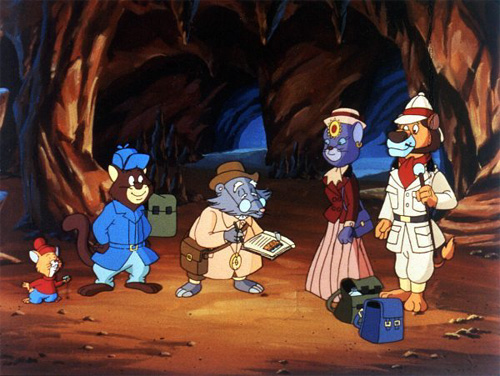
Shortly after Fogg, his servant Rigadon, and Lidenbrock depart, they realize (in
a scene reminiscent of WHERE TIME BEGAN) the need for the practical help of Fogg’s
wife, the Princess Romy (replacing Aouda from Around the World in 80 Days).
She and her humorous servant Tico join the expedition, with Hans added as guide
when they reach Iceland. In another echo of Around the World in Eighty Days,
Sullivan hires the villainous Transfer to ensure that Fogg fails.
The traditional episodes are dramatized: becoming separated and lost, the underground
sea, crossing on a raft, and encountering sea monsters. There is direct borrowing
from WHERE TIME BEGAN in a forest of apparently fossilized turtle shells which turn
out to be not only alive but carnivorous. Exploding the passage that leads to the
surface creates a tidal wave that carries the raft upward, and to make the episode
plausible, Lidenbrock explains that the water is evaporating from the temperature
of the molten lava underneath. Carrying Saknussemm’s diary, found underground,
Fogg rushes to show it to the mayor of the village and win the bet.
The addition of Fogg (taking the place of Axel) and the concept of a race and wager
do little damage to the original narrative, enhancing the element of suspense. Lidenbrock
is a less significant character, but the primary episodes in the novel remain. The
animation style is modest, with minimized movement, but sufficiently elaborate and
colorful so as not to be noticeably cheap. The 74 minute production was produced
by B.R.B. International, S.A., and created by Claudio Biern Boyd, with general supervision
by Iñaki Orive, and a “literary adaptation” by Rafael Soler,
with the English script by Steve Edwin, John Vernon, and Terry Wilson.
The achievements of animation would continue to overshadow the resumption of live
action versions. In early 1996, executive producer Robert Halmi, Sr., whose Hallmark
Entertainment was simultaneously making a new version of 20,000 LEAGUES UNDER THE
SEA for CBS (which eventually formed the basis for a two-hour telefilm and a one-hour
children’s special the next year) announced a two-hour version of JOURNEY
TO THE CENTER OF THE EARTH for the Sci-Fi Channel, from a script by John Ireland.
In the wake of the commercial success of the USA Network’s four-hour mini-series
of MOBY DICK (1998), the project was switched to USA, the Sci-Fi Channel’s
parent company, and the two-hour telefilm was expanded to four hours (including
commercials) with Thomas Baum enlarging Ireland’s script. Director George
Miller, already attached to the project, was eager for the change, and produced
with Connie Collins. Shooting began in April 1999 in Australia and New Zealand on
a $12 million budget, and the miniseries premiered five months later on September
14 and 15.[19]
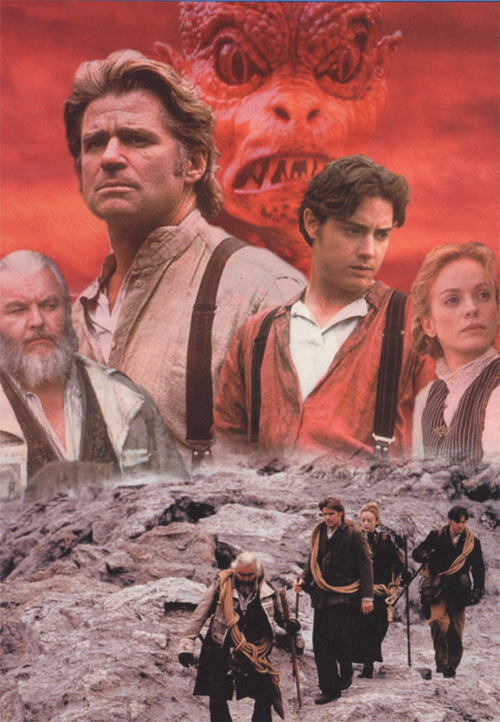
The setting is given as 1868 and adapts the nationality and names of its protagonists
to the cast. Instead of the German Professor Otto Lidenbrock, the hero is the American
name-alike Theodore Lytton. As portrayed by 47-year-old Treat Williams, Lytton is
as much an action hero as part of the world of science, thereby surmounting the
unlikelihood of a man of his constitution surviving the expedition. He studied with
Darwin in the Galapagos, and is a rather dominating father-figure to his initially
fearful young nephew, Jonas (Jeremy London), who is indispensable to his uncle for
having a facility for languages that Lytton lacks. Jonas is in love with the profoundly
unsympathetic homebody, Helen (Tessa Wells), taking the place of Verne’s Graüben.
Alice Hastings (Tushka Bergen), a wealthy American mountaineer and member of the
Carnegie family, hires Lytton to search for her husband, Casper (Bryan Brown). Casper
had climbed down in a remote part of New Zealand, the Ruapehu caverns that descend
deep inside the Earth and are rumored to be an area of monsters and mystery. Like
the addition of Fogg in the 1998 Spanish animated version, this new narrative strand
is only one of several changes that incorporate aspects of another Verne novel,
his 1867 epic, The Children of Captain Grant. Just as Mary Grant is part
of the trek looking for her father, which will end in her marriage, Alice is part
of the expedition in search of her husband, which will eventually bring her a new
spouse. Two-thirds of The Children of Captain Grant is set in Australia
and New Zealand, and the shift in the setting of Journey to the Center of the Earth
is partly to utilize filmmaking locations there.
The phlegmatic Icelander Hans is replaced with the burly, kilt-wearing MacNiff (Hugh
Keays-Byrne). He integrates the Scotsman MacNabbs and the underhanded Ayrton from
The Children of Captain Grant. Unlike Hans, but in line with his antecedents
in The Children of Captain Grant, MacNiff is a crack shot, a hard-drinking
(but sober) ex-convict, wily enough to steer the Lytton party through the dangers
of a colonial rebellion and hostile Maoris, engaging in a bit of gun-running to
ensure native cooperation.
Unlike previous films of Journey to the Center of the Earth, the descent
is in a tropical climate filled with vegetation. The Lytton party encounter profound
heat (140 degrees Fahrenheit), but also the usual episodes of searching for water
and the nephew becoming isolated. (A shot of the group crossing a rock bridge that
crumbles after them into a fiery pit is almost directly lifted from the 1959 movie
JOURNEY TO THE CENTER OF THE EARTH, with which the filmmakers of the 1999 version
were familiar.[20])
Wind blowing Alice’s hair reveals a passage emerging on the shore of the underground
sea, with the cavern roof supported by pillar-type columns of rocks, perhaps the
most impressive visualization yet achieved. Like the 1977 Piquer Simon version,
a shift of natural colors is used to convey an other-worldly impression, with a
yellow sky and blue plants. Jonas had already discovered insect-type prehistoric
life on their descent, so the explorers are hardly surprised when they spot a magnificent
flock of pterodactyls flying in the air. Like the 1959 movie, however, the crossing
of the ocean is truncated, this time in a boat made of straw rather than a raft,
and again avoiding Verne’s dinosaurs at sea in favor of unconvincing land-based
creatures. The 1977 Piquer Simon feature remains the only film to visualize the
central part of the story as Verne told it.
On the shore, Jonas glimpses and follows Ralna (Petra Yared), a remarkably agile,
tattooed redhead, who leads them into a jungle were they encounter two new races.
There is a primitive but more physically developed humankind, together with a reptile
race, Saurians, that has developed on a parallel path, with its own language, science,
and urban centers in a world where human and dinosaur coexist. Alice is abducted
by the Saurians, and in the human village Lytton, Jonas, and MacNiff find Casper,
living as their ruler, in a manner reminiscent of a cult leader or Kurtz in Joseph
Conrad’s Heart of Darkness.
While the subterranean world is offered as an example of a different outcome of
Darwin’s theories, the theme is insufficiently explored, and the second half
of the miniseries is disappointing. The filmmakers are unable to develop an adequate
destination for the expedition, refusing to allow the journey itself to serve as
the goal, as in the novel.
Miller’s version further demonstrates how films of Verne’s novel and
Conan Doyle’s Lost World, itself inspired by the Frenchman’s
book, have become a source of shared inspiration for filmmakers. Conan Doyle’s
novel was even more concerned with the rivalry of races of prehistoric man than
the better-remembered perils provided by dinosaurs. During the production of this
version of JOURNEY TO THE CENTER OF THE EARTH, two new films of The Lost World
were made, one a pilot for a television series shot in New Zealand, so certainly
the ideas from the Conan Doyle novel were very much “in the air.” Indeed,
one episode of the ensuing 1999-2002 THE LOST WORLD series, HOLLOW VICTORY, was
a Verne pastiche, descending underground this time via balloon. Other ideas in a
similar vein derive from another classic source, Edgar Rice Burroughs’s Pellucidar
saga.
Casper dies on the return journey, and crossing the underground sea again, Jonas,
Lytton, and Alice are abruptly sent to the surface by a vortex phenomenon. Saknussemm
(in the only context in which he is mentioned) is said to have predicted this: underground
storms which turn into giant waterspouts that feed surface lakes. Lytton and Alice
decide to honeymoon in Iceland, and explore fresh caverns that may offer a more
direct route to the center of the Earth (which has the curious effect of making
the Verne novel seem like a sequel to this film adaptation).
Jonas must recover from an unknown virus transmitted by Ralna, that leaves him with
dreams of her and causes him to leave Helen behind and return to New Zealand and
a life of adventure--clearly leaving the way open for a sequel. The theme of Jonas’s
initiatory trajectory and his gradual emergence as a hero during the course of the
journey remains from the novel, despite deviating from Verne’s romantic conclusion
(which the Lytton-Alice nuptials render superfluous).[21]
During the first few years of the 21st century, new versions of JOURNEY
TO THE CENTER OF THE EARTH continued to be announced but remained unproduced. Finally,
in 2007, a new big budget version was made, JOURNEY TO THE CENTER OF THE EARTH 3-D,
and as so often happens, simultaneously two lower budget renditions of the same
story were made to cash in on the former’s anticipated popularity, one by
Robert Halmi for television, and another direct-to-video by The Asylum. Halmi’s
appeared first, and like his 2005 version of MYSTERIOUS ISLAND, the filmmakers did
not return to the novel, but chose instead to remake an earlier adaptation.
Robert Halmi, Sr. dusted off the script of his 1999 version of JOURNEY TO THE CENTER
OF THE EARTH, compressing it back to a 90 minute telefilm for RHI entertainment
that appeared on the ION network on January 27, 2008. William Bray adapted the 1999
Tom Baum teleplay, this time helmed by T.J. Scott. The principal characterizations
and motives remained the same, only compressed and more tightly paced.
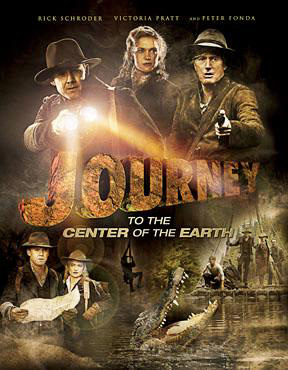
The setting remains around the 1870s but is transplanted to San Francisco and Alaska,
still known as “Seward’s Folly” and with vestiges of Russian influence.
These locales and a center of the Earth that resembles it were all a result of the
Vancouver location shooting determining production design. However, the switch to
an American background also gives the adaptation more of a natural, domestic, and
less of an exotic feel-distinct from previous versions, which is a strength, but
also familiar types of scenery, such as a western-style Alaskan town and costume.
While director Scott makes the most of the backgrounds, the fact that the center
of the earth looks almost exactly like the world above makes the narrative ultimately
less convincing. Far more memorable were the unusual visuals achieved by the 1999
version.
From the first scene it is clear that this is little more than a retelling of the
earlier film, with the basic characters and situation remained as before. Anthropologist
Jonathan “Uncle Jonas” Brock, like Theodore Lytton, is engaging in boxing
bouts while his nephew Abel (in place of Jonas in the 1999 film) handles the betting
to try and earn the money for an expedition to the Dutch East Indies. Neither Rick
Schroeder nor Steven Grayhm, respectively, is as appropriate for their roles as
were Treat Williams and Jeremy London in 1999. Schroeder lacks the physical strength
of Williams and is scarcely credible as a pugilist, while Grayhm is unable to reflect
the transformation the journey exerted on London.
By contrast, the wealthy Martha Dennison, instead of Alice Hastings, who hires the
Brocks to search for her husband, is incarnated this time much more vigorously and
convincingly by Victoria Pratt. She has a decade of female action roles to her credit
and is also the wife of director Scott, with a long list of collaborations together.
Dennison has a map supposedly leading to a mine shaft which goes to the center of
the Earth, down which her husband Edward had descended four years earlier and never
returned. Dennison is presented as the daughter of a mine owner, who had grown up
surrounded by men and is consequently unconcerned about the perils and discomfort
of the expedition, as well as the exclusively male companionship. As before, part
of her motive is to redeem her role in a marriage gone sour.
Central to the rapid unfolding of the story is the reliance on the first person
narration ostensibly from the diary kept by young Abel, who dedicates it to his
fiancée, angry at his departure on the journey. Most intriguing is the change
in the Hans character; in place of the 1999 mini-series verging into The Children
of Captain Grant territory with the Scot MacNiff and Maoris, the new version
offers a Russian outlaw, Sergei, whose brother had descended with Edward. This provides
an appropriate shift of character that merges with the new locale, and also, unlike
all previous versions, a compelling reason for the “guide” to descend
with the others. Sergei is also vital in helping the expedition reach the lake where,
according to the map, on a single July day of the year the sunlight will point out
the location of the mine.
There is an attenuated telling of the journey to the underground lake. The only
marker among the caves is one at the beginning, in Russian, telling them the correct
initial cave to take. (There is no mention of Saknussemm.) On the way, the remains
of Sergei’s brother are found.
By the shore, trees freshly felled with an axe indicate an earlier traveler, and
they decide to also make the journey by raft. Prehistoric birds and a plesiosaur
attack the raft, creatures described as extinct since the ice age. The use of effects
is brief and has little impact on the story. Subsequently the film veers in new
directions, as in the 1999 version, leaving Verne’s novel behind.
An encounter at the shore with a wrecked raft leads to natives who resemble Native
Americans, leads, predictably, to finding Edward (Peter Fonda, a modest improvement
over the 1999 film’s Bryan Brown as Caspar), who has taken advantage of superstition
and made himself king. Here is a plot device Verne used himself in The Aerial Village,
also involving a trek deep into the unknown, in search of a man who turns out to
have become a false high priest to a “missing link” ancestor of humankind.
Edward demands the expedition bow down to him and turn over their firearms; Martha
finds him to have the same sense of entitlement that disrupted their marriage in
the surface world. The tribe here are ancient Tlinkits, who made the journey and
settled ages ago. Some warriors are resisting Edward’s rule, and when he heartlessly
shoots a helpless youth point-blank, the disillusioned Martha slaps him so hard
that he bleeds. This begins to undercut his divinity, in a moment reminiscent of
THE MAN WHO WOULD BE KING (1975).
Fleeing the angry tribes, now united in opposition, Edward leads the way to a cave
reputed to be the way out. Unlike the 1999 version, he is allowed redemption by
sacrificing himself to save the others by staying behind to guarantee a dynamite
charge that will block the cave. Water overcomes the foursome until finally they
are sent to the surface of a lake in a waterspout-a theory which early in the story
Martha had proposed and Jonas had dismissed. They decide to save the tribe from
further exploitation by the above-ground world and Abel will keep his diary secret,
or in fact, say-as he does in the final sentence-that it is merely a piece of fiction.
Meanwhile, Jonas and Martha have realized their attraction for each other.
In this version, the more rapid pacing does not allow the viewer to be quite as
aware of the hokeyness of the subplot with the tribes as in the 1999 version. Mercifully
this time there are no Saurians or an affair between Abel and one of the underground
girls, or the Hans figure remaining behind to assume a similar position with the
tribes. The resemblance to Conan Doyle’s The Lost World is much less
pronounced. However, the emphasis on evolutionary themes to explain the various
plot points is lost, a thread that helped to hold together the 1999 miniseries.
Still, the principal question remains why the producers thought the script of the
1999 version was good enough to deserve a remake. Likely, as in the choice of the
Vancouver location, it was simply a matter of the most budget-conscious way to proceed.
Still it remains a valid question for audiences to ask.
The Asylum’s interpretation, released July 1, had the least in common of all
three of the 2008 films. A military and scientific experiment to teleport six female
soldiers from America to Europe goes awry, landing them deep inside the Earth, and
they find themselves fighting off dinosaurs, which is as close as the movie gets
to Verne. One line stands out, when, having run out of food, their leader suggests
there is one source of food—and one of the other women replies, “I don’t
want to eat a dinosaur.” The retelling written and directed by Scott Wheeler
and Davey Jones [sic] has a greater similarity with such well-known films that are
distinctly non-Verne as AT THE EARTH’S CORE and THE CORE, as well as two that
were ostensibly Verne-linked, UNKNOWN WORLD and the 1993 NBC television pilot of
JOURNEY TO THE CENTER OF THE EARTH. In these films, a mole-like vehicle burrows
underground to the rescue with remarkably unconvincing special effects. Intercut
are the perils the women experience, with one devoured by a Tyrannosaurus Rex and
another suffers a worse fate at the hands of a giant arachnid (left over from VALLEY
OF THE DRAGONS, the 1961 low budget movie of Hector Servadac?)
The Asylum is known for producing films from public domain stories, and with titles
reminiscent of big budget productions offered by major studios, so it is not surprising
for them to join the Verne bandwagon; in 2007 they had released an updated version
of Twenty Thousand Leagues Under the Seas entitled 30,000 LEAGUES UNDER
THE SEA. As weak as their JOURNEY TO THE CENTER OF THE EARTH is, it is vastly superior
simply as entertainment to 30,000 LEAGUES UNDER THE SEA. While the latter actually
had more in common with Verne, it was such a disservice to his premise that a film
like JOURNEY TO THE CENTER OF THE EARTH that simply abandons the author altogether
(except in name only) deserves less opprobrium.
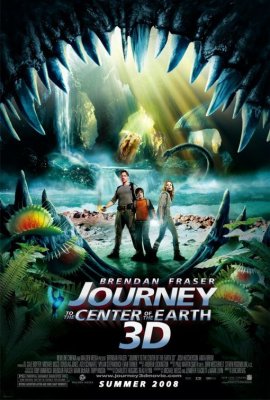
Fortunately, the new theatrical version of Voyage au centre de la terre
proved entirely different from its predecessors, and broke the decade-long hex on
Verne in the Hollywood cinema. This encompassed not only the previous two 2008 versions
of the same story, but also The Asylum’s 2007 release of 30,000 LEAGUES UNDER
THE SEA. The 2005 telefilm of MYSTERIOUS ISLAND and the Jackie Chan vehicle AROUND
THE WORLD IN 80 DAYS (2004) had both suffered from referring more toward previous
cinematic versions of both stories, in 1961 and 1956, respectively. The Verne pastiches,
THE LEAGUE OF EXTRAORDINARY GENTLEMEN (2003) and the 22 episode 2000 syndicated
TV series THE SECRET ADVENTURES OF JULES VERNE had little in common with their ostensible
sources. The 1999 miniseries of JOURNEY TO THE CENTER OF THE EARTH was also weak.
One has to go back to 1997, when American television offered no less than three
television versions of Twenty Thousand Leagues Under the Seas, that a worthy
Verne film had been made, the miniseries from ABC with Michael Caine.
Ironically, JOURNEY TO THE CENTER OF THE EARTH 3-D, is from the same production
company, Walden Media, that brought us Chan’s AROUND THE WORLD IN 80 DAYS
catastrophe. It is in contrast with it, and another summer release, THE LEAGUE OF
EXTRAORDINARY GENTLEMEN, that Walden’s JOURNEY TO THE CENTER OF THE EARTH
3-D stands out so strongly. A movie intended for the summer season, when the purest
escapism is expected from the widest audience, offers the greatest difficulties
for a potential adaptation. However, JOURNEY TO THE CENTER OF THE EARTH 3-D not
only achieves fidelity to Verne’s conception, but also includes a referential
dimension.
The filmmakers faced a further factor. During the height of Verne filmmaking, the
1950s through the 1970s, a new movie version would be presenting the story idea
afresh to cinema-goers and television viewers. By the 1970s, the movies of the preceding
two decades were beginning to show regularly on television. In the 1980s, with cable
and video, films began to repeat ever more often, and to be increasingly available
in formats for the home viewer. The 1959 JOURNEY TO THE CENTER OF THE EARTH is the
perfect example. Whereas once it was occasionally on network television, today it
is broadcast more than once a month on Fox Movie Channel, and has been available
on VHS and DVD since the birth of those mediums. Hence, for adaptations made in
the 1980s and beyond, new ways of telling a story may be pursued when straightforward
renditions have already been widely seen.
Admittedly, in most cases that liberty has been abused, often to the point of providing
a narrative at odds with the novel: mining the wonderful alliteration of the phrase,
“journey to the center of the earth,” and its simple yet profound central
idea. In this regard come to mind such films as ALIEN FROM L.A. (Cannon, 1988),
JOURNEY TO THE CENTER OF THE EARTH (Viacom, 1989), FUNKY FABLES: AN EXCELLENT JOURNEY
TO THE CENTER OF THE EARTH (Saban, 1991), JOURNEY TO THE CENTER OF THE EARTH (NBC,
1993), JOURNEY TO THE CENTER OF THE EARTH (USA, 1999), JOURNEY TO THE CENTER OF
THE EARTH (Ion, 2008), and JOURNEY TO THE CENTER OF THE EARTH (The Asylum, 2008).
Yet the new theatrical JOURNEY TO THE CENTER OF THE EARTH provides a case of the
optimal, most rewarding use of that freedom.
A summer film almost dictates a contemporary setting. The question then becomes
how to re-tell the story within that requirement—or to abandon it altogether,
as The Asylum had done. Director Eric Brevig himself had changed the initial 19th
century setting of the script of JOURNEY TO THE CENTER OF THE EARTH 3-D, believing
it needed to concentrate on the book’s highlights, to appeal to modern audiences.[22] He hoped to get
away from some of the elements that make the book unlikely from a scientific standpoint
to modern audiences, and to avoid the feel of a remake.[23]
The conceit of the 2008 movie becomes that Verne’s book is, in fact, nonfiction,
based on the account of someone else who made the trip. A straightforward version
could not have paid greater fealty to Verne. Following the book, the journey can
(and will) be duplicated, a notion at once making JOURNEY TO THE CENTER OF THE EARTH
3-D as much sequel and pastiche as adaptation, yet also erasing the difference between
them. (A similar duality was already found in Rick Wakeman’s 1999 rock opera
sequel to the novel, Return to the Center of the Earth.) While some purists
may point to the lack of a period setting, or the removal of Arne Saknussemm, without
this change, the movie could not have been such a direct and extended homage to
Verne and his memory.
While not noting Verne in the credits (in a closing sequence more clever than found
in any Verne film since Saul Bass’s at the close of Todd’s AROUND THE
WORLD IN 80 DAYS), his constant mention in the diegesis, and the showing of the
book and the original Édouard Riou engravings in the visuals, provide ample
tribute. Indeed, a conventional “based on” note would be redundant.
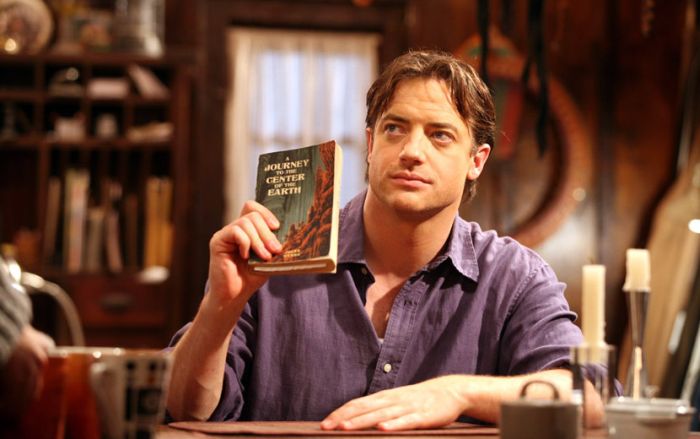
Unlike the expressed belief of Frank Coraci in directing the 2004 AROUND THE WORLD
IN 80 DAYS, who told SCI FI Wire that the characters had to be changed to make them
accessible to modern audiences, this next group of filmmakers at Walden to tackle
a Verne project had a different attitude to the source. This is a movie of taste
and intelligence, with reverence for Verne. In the planning of the movie, leading
man and first time executive producer Brendan Fraser had arrived with his own copy
of the Verne book, and mentioned its importance in many interviews.[24] “When I came aboard, it
was just a matter of figuring out what the character relationships should be. What
I pitched the director was the original story. An audience can’st keep interest
without interest in the characters.”[25]
He prevailed upon studio executives to revise the script’s father-son relationship
to the original one of uncle and nephew used by Verne, according to director Eric
Brevig.”[26] “I
went in to Walden Media and said, ‘Let’s go back to the book. Take the
relationships there, let the lead character be an uncle to a nephew, and let the
guide create the boy-girl friction, all on top of the backdrop of these big set
pieces, all the CGI elements and 3-D elements.”[27] The result is deceptively simple but also very
tightly plotted.
Perhaps the greatest sigh of relief in the movie among Anglophone Verne aficionados
comes when the characters refer to Verne’s prescient hero as Professor Lidenbrock;
fortunately, no one dragged in the misbegotten but endlessly reprinted translation
changing the character’s name to “Von Hardwigg” and his nephew
Axel to “Harry.” Brevig revealed to convention-goers that he was familiar
with the translation issues and the problems, and had referred to a modern edition.
One should see JOURNEY TO THE CENTER OF THE EARTH 3-D (the 15th film
of the book made around the world since 1909) in much the same light as earlier
renditions, utilizing Cinemascope (1959) or animation (Burbank Films, 1976), and
achieving the best results possible within their form. A fresh technology, computer-generated
3-D, further governed the adaptation of the novel. And I suspect that in this regard,
Jules is smiling and thinking to himself that Adolphe D’Ennery, who successfully
transferred several of his novels to the 19th century stage, could not
have served his premise better.
The suitability of Cinemascope to the subject matter was one of the reasons for
the 1959 version’s appearance as the first feature movie of the novel. Producer
Charlotte Huggins had been making 3-D films for IMAX and theme park attractions,
and had sought a property that could use the technology for a traditional theatrical
feature. “The ideal property would be something that took people into a place
where they would never, otherwise, get to go, like the center of the Earth.”
Walden Media was already developing a film of Voyage au centre de la terre,
and had made IMAX 3-D films, so was open to the concept of merging the two ideas.[28] 3-D is an essential
part of the visual design, from the opening title sequence of a live trilobite stepping
over the traditionally-seen formation of one in petrified rock. His antenna wiggles
directly at the audience, hinting at the trip to come—into a strange realm
where time has little meaning.
Hence, JOURNEY TO THE CENTER OF THE EARTH 3-D may have a significance beyond its
place in the Verne cinematic canon to one in film history. 3-D has become a new
tool for filmmakers to draw audiences into the theater and offer an experience not
to be found through either home video or electronic games, just as widescreen was
a half-century ago. It is entirely appropriate that Verne in the cinema be tied
in with such technological developments; such germinal Verne movies as 20,000 LEAGUES
UNDER THE SEA (1954) and AROUND THE WORLD IN 80 DAYS (1956) were both pioneering
in their use of widescreen. Moreover, they were, like this new JOURNEY TO THE CENTER
OF THE EARTH 3-D, aimed squarely at the family market, and this is where Verne’s
greatest box-office success has always been found. The book tie-ins for the movie,
aimed at children rather than adults, demonstrate its primary intended appeal, as
does the use of that favorite among the youthful fascination with dinosaurs, the
Tyrannosaurus Rex.
The basic troika of characters remain, the science, spirit, and strength--head,
heart, and hands; mind, soul, and body: the professor, his young nephew, and the
guide. There are no melodramatic additions or villains to provide tension beyond
the conflict with nature. Instead of Professor Lidenbrock, we have seismologist
Trevor Anderson (Fraser), unappreciated at his university. The Maxwell Anderson
Center for the Study of Plate Tectonics, named for his brother, has been studying
seismic activity and its relation to earthquakes for a decade.
His sister-in-law leaves nephew Sean (Josh Hutcherson), age 13, for a visit, and
while younger than Verne’s first person narrator Axel, Sean undergoes a similar
trajectory, while his age allows youthful filmgoers to relate more easily. (Is the
stretch of his age any more egregious than the melodious casting of pop idol Pat
Boone in the same role in 1959?) Sean’s father, Max, had been seen in the
opening pre-credits scene, pursued over a volcanic cliff by prehistoric creatures.
Max disappeared a decade earlier, and gradually throughout the movie successive
revelations are made about this barely-seen character and his discoveries. The added
incentive of finding Max, while not in the novel, adds to the maturation process
intended by Verne. Initially there is no love lost between uncle and nephew, but
subsequent events will allow the two to bond, willing to endanger their own lives
for the other.
Arriving with Sean are some of Max’s possessions, including the baseball mitt
intended as a gift for his son’s birthday and his carefully studied copy of
Verne’s Journey to the Center of the Earth. The book is full of notes
and even a cipher which, as in Verne’s telling, the nephew decodes. Here is
a clear displacement in the new narrative, Verne’s novel taking the position
of Saknussemm’s relic in the original. Verne’s book becomes the document
that adds a sense of mystery to the journey. Just as in the novel, 19th
century travelers follow in the footsteps of those who went before; in this film
the characters are using the novel itself as their guide.
One of the cryptograms in Max’s copy of Journey to the Center of the Earth
leads to the Asgeirsson Institute of Volcanolgy in Iceland, where Trevor and Sean
meet the late Asgeirsson’s daughter Hannah (Anita Briem). She explains that
her father was a Vernian—one of a small group who believed that what the author
wrote was, indeed, fact, and Hetzel editions can be seen on the book shelves.
Here is a neat twist on both Verne studies and Sherlockiana, which has long treated
Sir Arthur Conan Doyle as Dr. John Watson’s literary agent. Indeed, the “Vernian
lore blogspot” on the movie’s website http://www.journey3dmovie.com/ is a referential echo of
the story as well as an extended practical joke, a fictive blog by Max and Asgeirsson.
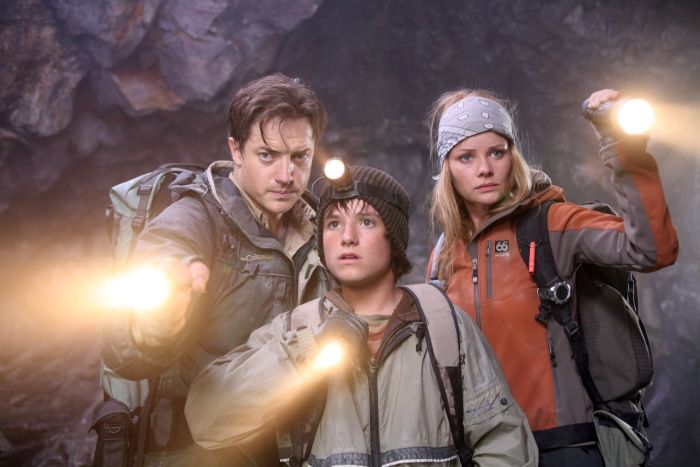
Hannah believes her father was foolish to be a Vernian, but since she is a mountaineer
herself agrees to guide Trevor and Sean to Mount Snaefells for pay. She thus assumes
the purpose of Hans in the novel, proving no less resourceful. She also provides
the easiest way of including female participation and romantic tension, necessary
in a modern retelling, without the tendency of other versions to add an additional
participant to the expedition. As Briem commented,
It was a great joy for me to develop a strong female character in the spirit of an Icelandic woman.... I think that came in very handy because as Hannah the mountain guide I often found myself in these very dangerous situations, and I have on one hand a geeky scientist and the other a small child, and they are both going to get us killed, so I have to intervene and save the day, regularly.[29]
Initially, the two males, Trevor and Josh, are dependent upon her, and only later
does Trevor’s scientific knowledge become an asset and Josh learn self-reliance
until both assume the mantle of heroes.
After some initial location views of the ascent of Snaefells, the interior of the
earth is entirely recreated through imagination, and computer-generated backgrounds
that resemble the matte shots of earlier films, rather than using any of the authentic
scenery such as Carlsbad Caverns in the 1959 version or the Canary Islands in WHERE
TIME BEGAN. Trapped by a rockslide, there is no way but forward. Lighting a flare
ignites a cave of magnesium, and the movie emulates Verne’s own habit of concealing
pedagogical purpose (in this case geology) in the guise of an exciting narrative.
Descending, they arrive at an abandoned mine shaft, board its rail. The subsequent
roller-coaster style ride aboard a mine car is both reminiscent of Tokyo Disneysea’s
“Journey to the Center of the Earth” and a blueprint for possible rides
in the future.[30] The
Tokyo ride devoted to the novel, like this part of the JOURNEY TO THE CENTER OF
THE EARTH 3-D, depicts a mine excursion into one amazing underground world of colors
and monsters conceived by Verne, and it is this the film references, not, as some
critics have suggested, INDIANA JONES AND THE TEMPLE OF DOOM. The filmmakers are
recognizing that audiences may be as familiar with the 1959 film, the Tokyo Disney
ride, as much as the original novel.[31]
The terminus of the mine proves to be a deposit of emeralds, rubies, and diamonds,
evidence of a volcanic tube ascribed to Verne. However, the thin sheet of Muscovite
on which Trevor, Hannah, and Sean stand shatters when he greedily snatches a diamond.
They fall an incalculable distance before finally reaching waterslides that gradually
rise in bubbles until it surrounds them.
In a grotto, bioluminescent birds extinct for millions of years lead them to the
center of the earth: waterfalls and a sea lit by an underground sun. Here is the
world Verne described, but recreated in an entirely fresh manner, lush and verdant,
full of vibrant colors, teeming with all the signs of life. This image was the centerpiece
of the original poster art and website reflecting the 3-D.
Trevor reads aloud from the book as they walk past the mushroom forest of the novel.
The skepticism that both Hannah and Sean had in their fathers and the unorthodox
belief they shared has been wiped away, transforming the perspectives of the two
characters and making them into eager participants in the expedition. Trevor’s
faith in his brother, too, is validated, and Josh regrets that he had not read the
book for the understanding it would have given him. From the outset, with a skeptical
colleague of Trevor’s eager to pull the plug on Max’s laboratory, through
the doubts of Josh and Hannah, the screenplay carefully validates another troika,
off screen but no less a part of the story. The trek becomes one of redemption of
not only Asgeirsson and Max and their ideas, but Verne and his literary wonders.
A tree house, first thought to have belonged to Lidenbrock, is recognized as Max’s.
Here is a another extra-textual homage to a different group of castaways, this one
outside of Verne, to the Swiss Family Robinson of Johann Wyss, the 1960
Disney film of that book, and the subsequent Disney theme park attraction—appropriated
for a different hero in the 1990s in the wake of Disney’s TARZAN adaptation.
Hannah discovers the body of Max nearby. A cairn is built by the underground sea,
stunningly designed in a sunset view, as Trevor reads from his brother’s diary
ten years earlier. However, there can be no lingering, for the rising temperature
indicates volcanic magma is preparing to boil this cavern. The only exit is to continue
the path of Verne’s travelers, building a raft to cross the sea and find the
vent on the other side.
For the first time, the underground prehistoric life, so integral to the novel,
becomes central to a film adaptation. Only Juan Piquer Simon’s 1977 live-action
feature, WHERE TIME BEGAN, had attempted the ocean creatures.
A storm breaks out, in a scene slightly reminiscent of the squid fight in Disney’s
20,000 LEAGUES UNDER THE SEA. The raft is overrun with flying, fanged fish, fought
off with sticks used like baseball bats. In turn, larger sea beasts, probably plesiosaurs,
appear, surrounding the raft, but fortunately they are hungry for the flying fish,
not humans. As the storm’s velocity increases, Sean tries to rescue the kite
they use as a sail, and finds himself lifted aloft into the elements, in a manner
reminiscent of the boy flying in a kite in Verne’s 1888 novel, Deux Ans de
vacances.
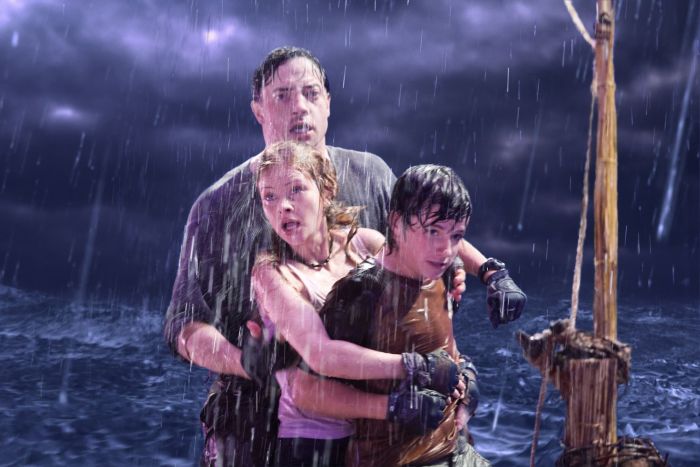
Sean wakes alone, ashore, as Trevor and Hannah search for him from the spot where
the raft wrecked. Their respective journeys are crosscut as they hope to meet by
following the predetermined plan to search for Verne’s vent to the surface.
Here is a perfect approximation of Axel’s own solitary journey when he is
lost. When Trevor decides to go in search of Sean and potentially miss his own opportunity
to escape, Hannah realizes her attraction for him.
Guided only by one of the bioluminescent birds, Sean discovers that the compass
found by his father’s body goes wild, and enters a region where rocks float
in the air. Amidst prehistoric bones is a Tyrannosaurus Rex, and Trevor finds Sean
and diverts the predator toward another layer of Muscovite that collapses under
its weight.
In the chimney, Hannah paddles in the jawbone of another Tyrannosaurus Rex toward
Trevor and Sean, replacing the novel’s raft (and the 1959 movie’s altar
stone). Trevor realizes that the cold walls of the shaft, indicate nearby water,
and frees it with another flare igniting the magnesium in the rocks. The water provides
a cushion between the rising magma and the skull as they are shot out of Mount Vesuvius.
In all these respects, the escape is made more credible than Verne’s explanation,
especially to a more scientifically-aware generation.
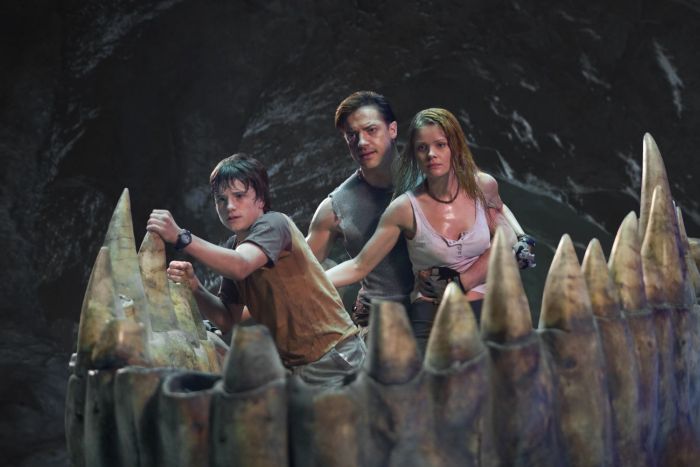
Back at the surface, they take another “roller coaster” style ride,
this time aboard the skull downhill through a vineyard, bringing to closure the
mine ride that had opened the journey. The landowner can be mollified with some
diamonds Sean has brought back with him, and which will provide for his uncle’s
new lab. Another prehistoric relic Sean brought to the surface escapes, one of the
bioluminescent birds, which became a good luck companion, especially when Sean was
alone. Not only did the bird fill the familiar R2D2 function from STAR WARS, it
recalled another item often serving as a source of additional inspiration in filming
Journey to the Center of the Earth, Arthur Conan Doyle’s The Lost
World, in which a baby pterodactyl is brought back to London.
In JOURNEY TO THE CENTER OF THE EARTH 3-D, all the vital motifs, characters, and
themes of Verne’s novel are retained, as far as possible in the format of
a summer “thrill ride” movie. Episodes are either replaced or approximated
within the script’s new narrative. The major change is to have the journey
take place over days, rather than weeks, with a running time of 92 minutes.
Some may miss the 19th century period, or the enigma provided by Saknussemm’s
legacy. And certainly this version lacks the epic quality that the 1959 version’s
132 minute running time allowed (and which was also partly a function of that movie’s
Christmas season release). The deliberate pace of the trek in the wake of Saknussemm
is replaced by a series of accidents—the rockslide, mine, and the shattered
muscovite--that cause the descent in JOURNEY TO THE CENTER OF THE EARTH 3-D. Similarly,
the camerawork is quick and fragmented, unlike the more classical framing of the
1959 film. However, as I argued earlier, with that movie so readily available, and
indeed so capably achieved, there seems little need to remake it on its own terms.
Journey to the Center of the Earth is primarily a chronicle of incidents
that do not have the overt depth of character that allows, for instance, so many
different screen interpretations of Twenty Thousand Leagues Under the Seas.
Moreover, such first person narratives as Journey to the Center of the Earth
are notoriously difficult to handle visually, although they do lend themselves to
the strictly audio form.
The period setting becomes largely irrelevant in a story set mostly underground;
the contrast with prehistoric life below ground continues. The 3-D effects themselves
serve to enrich the visual presentation of a story where the otherworldly dimension
is so key a part, from the opening shot of a fossil trilobite to a living one, wiggling
its antenna at the audience. I found only a few scenes unsuccessful, such as an
encounter with carnivorous plants too reminiscent of “B” jungle movies.
Granted much of this movie can be seen as a filmic theme park ride, but since that
was its purpose, it is more reasonable to judge this film by its achievements within
this stylistic, rather than bemoan the form of filmmaking itself.
Further compensating virtues are its refusal to enhance the conflict through added
characters or destinations (whether the time traveler in the 1977 film, or Atlantis
in 1959). The principal actors all prove more than competent to enliven their roles.
Andrew Lockington’s score is ideal, and the script by Michael Weiss, Jennifer
Flackett, and Mark Levin evidences clever duality of structure: Muscovite and magnesium
both imperil and save, just as Max’s Journey to the Center of the Earth
was originally unearthed alongside a baseball mitt—and baseball-type athletics
save the raft from the flying fish. The homage to the source is warm, never campy,
and steadily leavened with humor. For instance, during the battle with the flying
fish, Sean’s cell phone abruptly begins to work underground, an amusing incident
that also serves to underlie the sense of place.
Unfortunately, at the last minute JOURNEY TO THE CENTER OF THE EARTH 3-D has had
to drop 3-D from the title in many screenings, owing to a lack of theaters ready
for the new systems. It had already been held back for a full year precisely because
not enough theaters were equipped for it. Having been made on a relatively modest
budget of $54 million (with ten weeks of principal photography, in Montreal), JOURNEY
TO THE CENTER OF THE EARTH 3-D could not open in 3-D in all theaters. This required
simultaneous release in many theaters with only “flat” prints, lacking
the 3-D.
Actually, the movie has done astonishingly well at the box-office, considering it
received little advertising because so many theaters were unprepared for 3-D. While
Verne may not be in the same league with such current competitors as Batman (THE
DARK KNIGHT) or Pixar’s (WALL-E), despite this competition, JOURNEY TO THE
CENTER OF THE EARTH 3-D was already in the black by its third week, before overseas
revenues, cable, and video. While not enough of a hit perhaps to suggest another
Verne filmmaking cycle, it has reversed the failure of Chan's AROUND THE WORLD
IN 80 DAYS.
The versions of Journey to the Center of the Earth provide a paradigm of
the adaptations of Jules Verne in the diverse media of movies and television. Each
production is very different, even those ostensibly continuing another adaptation,
such as the 1959 feature and the subsequent Filmation animated series. Like so many
Verne stories, there is a single Hollywood big-screen “version” that
provides the widely known yardstick. While appropriately celebrated, others equally
deserving have been overlooked, most notably the Spanish movie, WHERE TIME BEGAN,
and the 1976 animated A JOURNEY TO THE CENTER OF THE EARTH, the most artistic version.
Every adaptation was aimed at fundamentally different audiences. Worldwide mainstream
viewers were the objective of the 1910, 1959, and 2008 3-D movies. Youthful filmgoers
were the target in more specialized venues like WHERE TIME BEGAN and JOURNEY TO
THE CENTER OF THE EARTH 3-D, with children for the animated versions and WISHBONE:
HOT DIGGETY DAWG.
The writings of Verne, particularly this novel, demonstrate their malleability to
animation, a form demanding altered techniques and narrative approaches from live
action. The medium of the small screen has been most typically associated with these
productions, running the gamut from the low grade efforts for the 1967-69 JOURNEY
TO THE CENTER OF THE EARTH series, to the Australian A JOURNEY TO THE CENTER OF
THE EARTH in 1976. Each of the animated versions has been created in its own, strikingly
different style, from the minimalism of series television, to the juvenile caricatures
of AN EXCELLENT JOURNEY TO THE CENTER OF THE EARTH, and ultimately the detailed,
quality efforts in the aforementioned 1976 version, A JOURNEY TO THE CENTER OF THE
EARTH.
Films have logically tried to fill in more details about Arne Saknussemm, a character
whose background Verne leaves so enigmatic, and possibly this is the screen’s
single greatest narrative contribution to the story. Among animated versions, the
1976 A JOURNEY TO THE CENTER OF THE EARTH and the Willy Fogg JOURNEY TO THE CENTER
OF THE EARTH both add details about Saknussemm’s fate and that of his companions
on that long-ago first journey. Again, the creativity of animation trumps live action
in this regard, whether the 1959 version examining him through the portrayal of
his descendant, Count Saknussemm, or ALIEN FROM L.A. providing a modern day Saknussemm
and his daughter.
Every version of Journey to the Center of the Earth has demonstrated the
ever-increasing intertextuality of these adaptations. The films increasingly reflect
not only the novel, and an attempt at adaptation, but more and more frequently are
equally influenced by previous films of the story. Whether adding to the youthful
mix of the underground explorers or finding Atlantis, films expand the original
Vernian “text” to include new elements. So many of these Verne productions
have now been made and are repeated endlessly on television that he has been initially
encountered through screen renderings by most of the last two generations of audiences,
making such adaptations a defining experience in the discovery of this author. JOURNEY
TO THE CENTER OF THE EARTH 3-D demonstrates how this has progressed to the point
where it is possible to simultaneously craft a film which serves at one and the
same moment as a pastiche and adaptation.
Perhaps part of the novel’s appeal is its premise, transcending science fiction
to present an adventure which can never be realized, yet still retains a powerful
grip on human curiosity. For it is also a fantasy of the ultimate conquest of nature,
traveling through its most hidden recesses to regions that will never be seen. Journey
to the Center of the Earth offers the reader and moviegoer not only a prehistoric
world, but one entirely of the imagination, a realm conjured by the mind of Jules
Verne, and ever more often by the magicians of the screen who have found his idea
a source of inspiration.
 © 1993 - 2025 North American Jules Verne Society, Inc. — a 501(c)(3) Corporation
© 1993 - 2025 North American Jules Verne Society, Inc. — a 501(c)(3) Corporation